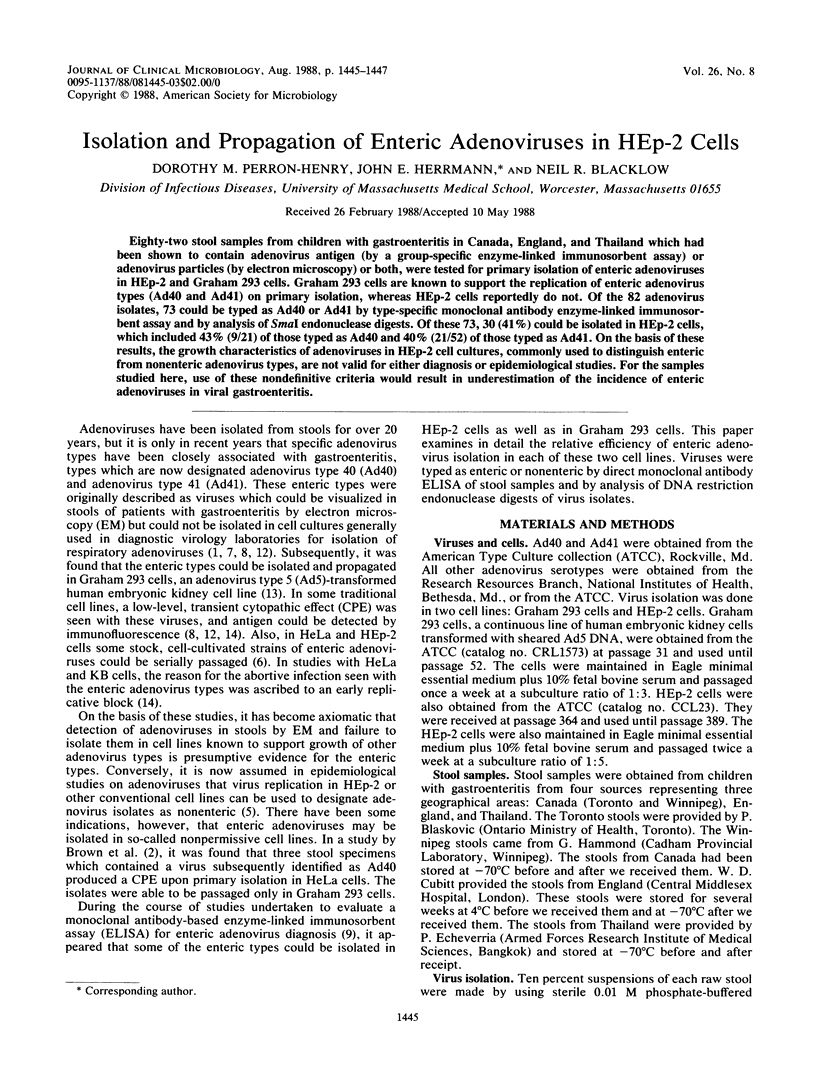Abstract
Eighty-two stool samples from children with gastroenteritis in Canada, England, and Thailand which had been shown to contain adenovirus antigen (by a group-specific enzyme-linked immunosorbent assay) or adenovirus particles (by electron microscopy) or both, were tested for primary isolation of enteric adenoviruses in HEp-2 and Graham 293 cells. Graham 293 cells are known to support the replication of enteric adenovirus types (Ad40 and Ad41) on primary isolation, whereas HEp-2 cells reportedly do not. Of the 82 adenovirus isolates, 73 could be typed as Ad40 or Ad41 by type-specific monoclonal antibody enzyme-linked immunosorbent assay and by analysis of SmaI endonuclease digests. Of these 73, 30 (41%) could be isolated in HEp-2 cells, which included 43% (9/21) of those typed as Ad40 and 40% (21/52) of those typed as Ad41. On the basis of these results, the growth characteristics of adenoviruses in HEp-2 cell cultures, commonly used to distinguish enteric from nonenteric adenovirus types, are not valid for either diagnosis or epidemiological studies. For the samples studied here, use of these nondefinitive criteria would result in underestimation of the incidence of enteric adenoviruses in viral gastroenteritis.
Full text
PDF


Selected References
These references are in PubMed. This may not be the complete list of references from this article.
- Brandt C. D., Kim H. W., Yolken R. H., Kapikian A. Z., Arrobio J. O., Rodriguez W. J., Wyatt R. G., Chanock R. M., Parrott R. H. Comparative epidemiology of two rotavirus serotypes and other viral agents associated with pediatric gastroenteritis. Am J Epidemiol. 1979 Sep;110(3):243–254. doi: 10.1093/oxfordjournals.aje.a112809. [DOI] [PubMed] [Google Scholar]
- Brown M., Petric M., Middleton P. J. Diagnosis of fastidious enteric adenoviruses 40 and 41 in stool specimens. J Clin Microbiol. 1984 Sep;20(3):334–338. doi: 10.1128/jcm.20.3.334-338.1984. [DOI] [PMC free article] [PubMed] [Google Scholar]
- Brown M., Petric M., Middleton P. J. Silver staining of DNA restriction fragments for the rapid identification of adenovirus isolates: application during nosocomial outbreaks. J Virol Methods. 1984 Oct;9(2):87–98. doi: 10.1016/0166-0934(84)90001-6. [DOI] [PubMed] [Google Scholar]
- Cepko C. L., Whetstone C. A., Sharp P. A. Adenovirus hexon monoclonal antibody that is group specific and potentially useful as a diagnostic reagent. J Clin Microbiol. 1983 Feb;17(2):360–364. doi: 10.1128/jcm.17.2.360-364.1983. [DOI] [PMC free article] [PubMed] [Google Scholar]
- Cevenini R., Mazzaracchio R., Rumpianesi F., Donati M., Moroni A., Sambri V., La Placa M. Prevalence of enteric adenovirus from acute gastroenteritis: a five year study. Eur J Epidemiol. 1987 Jun;3(2):147–150. doi: 10.1007/BF00239751. [DOI] [PubMed] [Google Scholar]
- Gary G. W., Jr, Hierholzer J. C., Black R. E. Characteristics of noncultivable adenoviruses associated with diarrhea in infants: a new subgroup of human adenoviruses. J Clin Microbiol. 1979 Jul;10(1):96–103. doi: 10.1128/jcm.10.1.96-103.1979. [DOI] [PMC free article] [PubMed] [Google Scholar]
- Herrmann J. E., Perron-Henry D. M., Blacklow N. R. Antigen detection with monoclonal antibodies for the diagnosis of adenovirus gastroenteritis. J Infect Dis. 1987 Jun;155(6):1167–1171. doi: 10.1093/infdis/155.6.1167. [DOI] [PubMed] [Google Scholar]
- Herrmann J. E., Perron-Henry D. M., Stobbs-Walro D., Blacklow N. R. Preparation and characterization of monoclonal antibodies to enteric adenovirus types 40 and 41. Arch Virol. 1987;94(3-4):259–265. doi: 10.1007/BF01310718. [DOI] [PubMed] [Google Scholar]
- Leite J. P., Pereira H. G., Azeredo R. S., Schatzmayr H. G. Adenoviruses in faeces of children with acute gastroenteritis in Rio de Janeiro, Brazil. J Med Virol. 1985 Feb;15(2):203–209. doi: 10.1002/jmv.1890150213. [DOI] [PubMed] [Google Scholar]
- Morris C. A., Flewett T. H., Bryden A. S., Davies H. Epidemic viral enteritis in a long-stay children's ward. Lancet. 1975 Jan 4;1(7897):4–5. doi: 10.1016/s0140-6736(75)92370-3. [DOI] [PubMed] [Google Scholar]
- Retter M., Middleton P. J., Tam J. S., Petric M. Enteric adenoviruses: detection, replication, and significance. J Clin Microbiol. 1979 Oct;10(4):574–578. doi: 10.1128/jcm.10.4.574-578.1979. [DOI] [PMC free article] [PubMed] [Google Scholar]
- Takiff H. E., Straus S. E. Early replicative block prevents the efficient growth of fastidious diarrhea- associated adenoviruses in cell culture. J Med Virol. 1982;9(2):93–100. doi: 10.1002/jmv.1890090203. [DOI] [PubMed] [Google Scholar]
- Takiff H. E., Straus S. E., Garon C. F. Propagation and in vitro studies of previously non-cultivable enteral adenoviruses in 293 cells. Lancet. 1981 Oct 17;2(8251):832–834. doi: 10.1016/s0140-6736(81)91104-1. [DOI] [PubMed] [Google Scholar]
- Uhnoo I., Wadell G., Svensson L., Johansson M. E. Importance of enteric adenoviruses 40 and 41 in acute gastroenteritis in infants and young children. J Clin Microbiol. 1984 Sep;20(3):365–372. doi: 10.1128/jcm.20.3.365-372.1984. [DOI] [PMC free article] [PubMed] [Google Scholar]
- Wadell G. Molecular epidemiology of human adenoviruses. Curr Top Microbiol Immunol. 1984;110:191–220. doi: 10.1007/978-3-642-46494-2_7. [DOI] [PubMed] [Google Scholar]
- de Jong J. C., Wigand R., Kidd A. H., Wadell G., Kapsenberg J. G., Muzerie C. J., Wermenbol A. G., Firtzlaff R. G. Candidate adenoviruses 40 and 41: fastidious adenoviruses from human infant stool. J Med Virol. 1983;11(3):215–231. doi: 10.1002/jmv.1890110305. [DOI] [PubMed] [Google Scholar]


